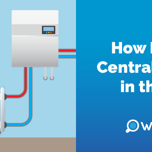Answer these simple questions and we will find you the BEST prices
Which type of solar quotes do you need?
It only takes 30 seconds
100% free with no obligation

Get up to 4 quotes by filling in only 1 quick form

Install a heat pump for less with the BUS grant

Increase the value of your home by installing a heat pump
- whatcost.co.uk
- Heat Pumps
- Replacement Installation
- Ground Source Heat Pump Installation
Ground Source Heat Pump Installation in the UK (2025)

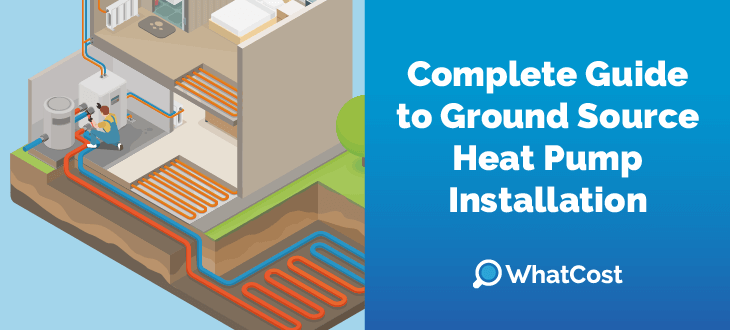
- A ground source heat pump installation can take just 1 - 3 days or up to 3 weeks, depending on your circumstances.
- Installing a ground source heat pump will cost between £16,200 and £49,000.
- They require very little maintenance, such as annual servicing and filter cleaning.
If you’re looking for a highly efficient, renewable way to heat your home, a ground source heat pump could be the answer. But how do these complex systems of underground pipes and indoor units actually work, and how complicated is it to install them?
In this guide, we’ll walk you through each step of the process, from ground excavations to expected costs and timings. We’ve got all your queries covered!
Finding the right advice and tracking down a qualified installer for your ground source heat pump installation can be stressful. Instead, you can avoid wasting hours of your free time by using our simple 30-second form. You can get up to 4 free quotes from our network of vetted, local installers.
You can compare prices and find the best deal in no time.
Just click below to get started.
- Quotes from local installers
- Payment by finance available
- Save £7,500 with BUS grant
It only takes 30 seconds

How to install a ground source heat pump?
Installing a ground source heat pump involves two key processes: the groundwork and the heat pump set-up. As there are two kinds of ground source heat pumps (those with vertical boreholes and those with horizontal trenches), the installation process is slightly different for each.
We’ve outlined below the typical steps involved when installing a heat pump:

1. Pre-planning and assessment
Before any installation, an assessment and preparation will need to be done. An installer will visit your home and determine the right kind of ground source heat pump for both your needs, and available space. For example, if you have a smaller area of land, you will need to opt for vertical boreholes, as these take up less space.
After evaluating your heating and hot water needs, your home insulation levels and the ground conditions, your installer can then arrange for the most suitable ground source heat pump system to be installed.
2. Groundworks
During the second phase of installation, the groundwork will begin. Depending on the design of your system, this will entail one of the following options:

-
Horizontal closed loop system
In this scenario, shallow trenches will be excavated of approx. 1 - 2m depth. Here, a series of ‘looped’ piping will be laid to draw heat from within the ground and cycle it back to your heat pump. This option requires a minimum of ½ an acre of land to be effective.

-
Vertical closed loop system
For those with limited ground space, vertical boreholes are often the best option. These holes are drilled vertically, to depths between 50m and 200m. Looped piping is then buried in the holes serving as a constant, efficient, source of heat collection that is cycled through your system.
3. Existing heating upgrades
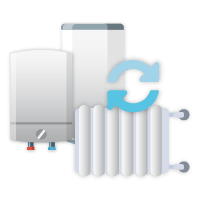
During the installation process, it may be necessary to remove, update or replace your existing heating systems. This can include replacing traditional radiators with underfloor heating, as this is the best way to distribute the most heat output from a ground source heat pump.
Depending on your existing systems and the advice from the installer, these steps can add additional days to the overall timescale. However, this should be discussed and agreed upon before any work begins.
4. Heat pump installation
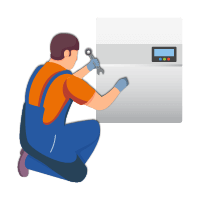
The next step is to install the heat pump unit. This involves fitting the heat pump and a hot water cylinder inside your home. Usually, these are stored in an outbuilding or plant room. The installer will then connect the indoor components to the outer ground loops, radiators, and hot water systems.
Once everything is integrated, controls and a thermostat will be set up, and the whole system will be thoroughly tested. After running all final checks, the installer will explain how to operate everything.
Following the installation, very little maintenance is required. However, an annual service will ensure your heat pump stays in great working condition throughout its lifetime.
Ground source heat pump installation diagram
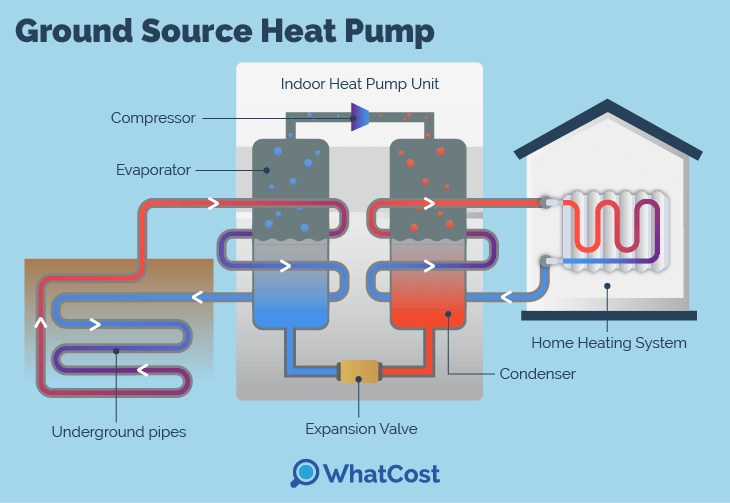
Once a ground source heat pump has been installed, a clever set of steps happens to heat your home and hot water. Starting with the underground pipes (laid horizontally or vertically), a thermal transfer fluid inside these pipes will begin absorbing heat from the ground.
This warmed fluid will pass through the indoor heat pump unit and transfer its heat to a refrigerant (a different fluid contained within the heat pump). The refrigerant then evaporates due to its increased warmth. It then passes through a compressor to significantly increase its temperature.
Now, as a very hot gas, the refrigerant travels through a type of heat exchanger (the condenser) to transfer its high temperatures to the home heating system (where it can be sent to radiators or hot water outlets).
After transferring its heat via the condenser, the refrigerant is passed through an expansion valve, reducing its pressure and temperature. At this point, due to cooling, it has turned back into a liquid and can cycle through the system again.
This whole process efficiently transfers and concentrates low-grade heat from the ground to provide higher-temperature heating for your home.
To find the right ground source heat pump for your needs, we recommend comparing offers from several installers. Seeking out trustworthy installers can take time though, leading to endless scrolling and phone calls. The good news is that you can skip the relentless searching and wait times and fill in our simple 30-second form instead!
You will receive up to 4 free quotes from qualified, vetted installers in your local area. You can then compare quotes and get your heat pump installation underway in no time.
Just click the link below to begin.
- Quotes from local installers
- Payment by finance available
- Save £7,500 with BUS grant
It only takes 30 seconds

Do you need planning permission to install a geothermal heat pump?
In most cases, you do not need planning permission to install a geothermal heat pump (aka ground source heat pump) in the UK. This type of installation is typically considered ‘permitted development’, meaning it can be done without formal planning permission. However, there are some areas where this may not apply.
For example, if you live in a conservation area, such as an Area of Outstanding Natural Beauty (AONB), or a listed building, it is likely you will need to obtain permission. It’s recommended that you speak to your local planning authority to ensure you comply with any location-specific regulations.
If you're unsure that a ground source heat pump is right for your home, read more about alternative options in our guide to air source heat pumps.
How long does a ground source heat pump installation take?
A ground source heat pump installation can take between 1 - 3 days. However, in some circumstances, it could take up to 2 or 3 weeks. It’s hard to estimate exactly how long your heat pump installation will take, as there are many factors that influence this.
Some things which can affect your installation time include:
-
Property size:
Larger properties may require more extensive groundwork and system integration. -
Ground conditions:
Soil type and accessibility can affect the ease and speed of groundwork. Weather conditions can also slow down work. -
Existing heating system:
More complex systems might require additional time for upgrades and integration.
During the initial quotation and assessment phase, your installer will be able to estimate a timeframe, so you know what to expect before work commences.
Is there maintenance needed after installing a ground source heat pump?
Following the installation of a ground source heat pump, there is very little maintenance required. The only thing you should ensure is that, as with any heating system, a regular service is undertaken once a year by a professional. They will check for any faults and confirm the system is working optimally.
It’s also important to familiarise yourself with your heat pump's performance throughout the year so that you can spot any changes and have issues rectified quickly. Ground source heat pumps typically last over 25 years, so it’s a good idea to follow any maintenance guidelines to maximise their lifespan.
Ground source heat pump installation cost
Installing a ground source heat pump typically costs between £16,200 and £49,000. These prices vary so widely as each home requires a different approach. We’ve outlined some price estimates in the table below to give you an idea of costs based on household and heat pump size.
| Ground Source Heat Pump Costs | |||||
|---|---|---|---|---|---|
| House Size | Heat Pump Size | Heat Pump Unit | Groundworks (Horizontal) | Groundworks (Vertical) | Full Installation Cost Estimates |
| 1 - 2 bedrooms | 8kW | £13,200 | £3,000 | £10,000 | £16,200 - £23,200 |
| 3 - 4 bedrooms | 12kW | £14,850 | £7,500 | £20,000 | £22,350 - £34,850 |
| 5 - 6 bedrooms | 16kW | £19,000 | £12,000 | £20,000 | £31,000 - £39,000 |
There are several factors which influence the cost of a ground source heat pump installation. The main factor to consider is the cost of groundworks. The size of land you have will affect whether you can opt for cheaper horizontal loops, or whether vertical ground source heat pump boreholes are needed.
The main cost difference occurs here because horizontal excavation is simpler and takes less time, whereas vertical digging requires specialised drilling equipment and can take longer.
Other key aspects with can impact costs include:
-
Property size:
Larger properties can require more powerful systems, increasing the capacity (measured in kW) can mean more expensive heat pumps. -
Complexity:
Aside from groundwork difficulties, other complexities can arise, such as integrating old heating systems or replacing old parts to ensure optimal performance overall. -
Labour:
The more complex the installation, the longer it is likely to take. This will mean additional labour costs. -
Location:
Depending on where you live, costs can also vary by region. That’s why it’s always recommended that you compare quotes from local installers to find the best possible price.
It's important to note that while ground source heat pumps have high upfront costs, they can offer long-term savings on energy bills, as much as £2,000 per year for some homes. In addition, government incentives like the Boiler Upgrade Scheme, can provide up to £7,500 towards installation costs.
Tracking down installers to compare costs can be a long and tedious task, but you can avoid all that scrolling and email checking by filling in our one simple form instead. We’ll put you in touch with up to 4 qualified, trusted installers from your local area who can provide you with ground source heat pump quotes and expert advice.
You can compare prices and find the best deal, without all the faff.
Just click the link below to get started.
- Quotes from local installers
- Payment by finance available
- Save £7,500 with BUS grant
It only takes 30 seconds

Can you install a ground source heat pump yourself?
Installing a ground source heat pump yourself is not recommended due to the complexity and technical expertise required. While you may be able to handle some aspects of the preparation, the core installation should be done by certified professionals.
There are several important reasons for this:
1. Compliance:
The installation must comply with Building Regulations and potentially the Microgeneration Certification Scheme (MCS) standards (if you wish to partake in any funding schemes).
2. System design:
Proper system sizing and configuration require expert knowledge to ensure optimal performance.
3. Specialised equipment:
Installation often requires specialised tools and machinery, especially for vertical systems with boreholes.
4. Safety:
There are significant safety considerations, including working with electrical systems and refrigerants.
5. Warranty and grants:
DIY installation may void warranties and disqualify you from heat pump grants in the UK, such as government incentives like the Boiler Upgrade Scheme.
Given the complexity and potential risks associated with ground source heat pump installation, professional installation is the most advisable route for ensuring safety, efficiency, and compliance with regulations.
How to find the right installer for your ground source heat pump?
To ensure you get the best installation for your home and needs, it’s recommended that you seek expert advice from several providers. This way, you can get a good understanding of what you need and compare costs, finding a deal that suits your budget.
When it comes to finding an installer, there are some key things you should look out for. Firstly, check their qualifications and certifications. For example, any MCS (Microgeneration Certification Scheme) certified installer will meet industry standards and is qualified to install heat pumps.
Secondly, checking reviews and others' experiences with a provider can help you discover those with the best service. In addition, it’s always best to opt for a local installer. They often have better availability and can offer the lowest prices.
Finding heat pump installers can be difficult on your own, often taking hours of time to research and find those you can trust. There is a way to avoid all this though! With our help, you can get direct access to a network of trusted, qualified installers.
Simply fill in our quick 30-second form, and we’ll connect you with up to 4 local installers who can provide free, no-obligation, quotes for you to compare.
Just click the link below to start.
- Quotes from local installers
- Payment by finance available
- Save £7,500 with BUS grant
It only takes 30 seconds

FAQ
This will entirely depend on whether you opt for a horizontal or vertical ground source heat pump installation. Horizontal ground loops are typically 1-2 meters deep, whereas vertical boreholes can be 50 – 200 meters.
A full ground source heat pump installation costs between £16,200 and £49,000. These costs are affected by factors such as the size of your home, the complexity of the work, and the time it will take to complete.
On average, 1 – 3 boreholes are enough for a UK home. However, this can vary depending on factors such as heating requirements, ground conditions and insulation levels in the home. It’s important not to attempt to install a ground source heat pump yourself, as this kind of excavation requires specialised equipment and professional planning.
For most homes, you do not need planning permission to install a heat pump. These are classed as ‘permitted development’, meaning they can be carried out without formal permission. However, there are some instances where permissions may be required, such as installation on listed buildings or in protected areas. Always check with your local planning authority if you are uncertain.

Becky has been bringing quality advice to homeowners since 2021. As an experienced writer, she is keen to help our customers find the help they need when they need it.
- Quotes from local installers
- Payment by finance available
- Save £7,500 with BUS grant
It only takes 30 seconds



